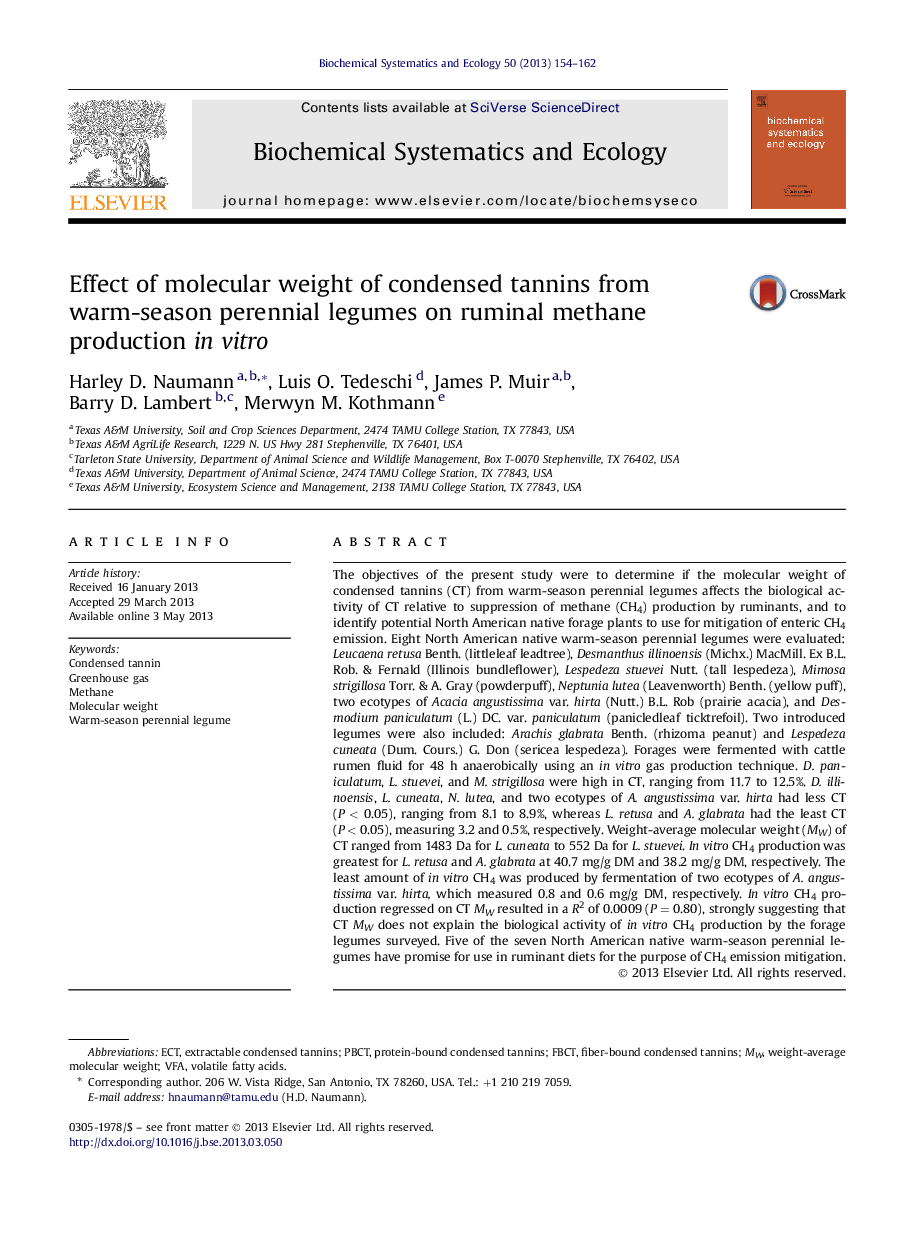| کد مقاله | کد نشریه | سال انتشار | مقاله انگلیسی | نسخه تمام متن |
|---|---|---|---|---|
| 7769257 | 1500416 | 2013 | 9 صفحه PDF | دانلود رایگان |
عنوان انگلیسی مقاله ISI
Effect of molecular weight of condensed tannins from warm-season perennial legumes on ruminal methane production in vitro
دانلود مقاله + سفارش ترجمه
دانلود مقاله ISI انگلیسی
رایگان برای ایرانیان
کلمات کلیدی
موضوعات مرتبط
مهندسی و علوم پایه
شیمی
شیمی آلی
پیش نمایش صفحه اول مقاله

چکیده انگلیسی
The objectives of the present study were to determine if the molecular weight of condensed tannins (CT) from warm-season perennial legumes affects the biological activity of CT relative to suppression of methane (CH4) production by ruminants, and to identify potential North American native forage plants to use for mitigation of enteric CH4 emission. Eight North American native warm-season perennial legumes were evaluated: Leucaena retusa Benth. (littleleaf leadtree), Desmanthus illinoensis (Michx.) MacMill. Ex B.L. Rob. & Fernald (Illinois bundleflower), Lespedeza stuevei Nutt. (tall lespedeza), Mimosa strigillosa Torr. & A. Gray (powderpuff), Neptunia lutea (Leavenworth) Benth. (yellow puff), two ecotypes of Acacia angustissima var. hirta (Nutt.) B.L. Rob (prairie acacia), and Desmodium paniculatum (L.) DC. var. paniculatum (panicledleaf ticktrefoil). Two introduced legumes were also included: Arachis glabrata Benth. (rhizoma peanut) and Lespedeza cuneata (Dum. Cours.) G. Don (sericea lespedeza). Forages were fermented with cattle rumen fluid for 48 h anaerobically using an in vitro gas production technique. D. paniculatum, L. stuevei, and M. strigillosa were high in CT, ranging from 11.7 to 12.5%. D. illinoensis, L. cuneata, N. lutea, and two ecotypes of A. angustissima var. hirta had less CT (P < 0.05), ranging from 8.1 to 8.9%, whereas L. retusa and A. glabrata had the least CT (P < 0.05), measuring 3.2 and 0.5%, respectively. Weight-average molecular weight (MW) of CT ranged from 1483 Da for L. cuneata to 552 Da for L. stuevei. In vitro CH4 production was greatest for L. retusa and A. glabrata at 40.7 mg/g DM and 38.2 mg/g DM, respectively. The least amount of in vitro CH4 was produced by fermentation of two ecotypes of A. angustissima var. hirta, which measured 0.8 and 0.6 mg/g DM, respectively. In vitro CH4 production regressed on CT MW resulted in a R2 of 0.0009 (P = 0.80), strongly suggesting that CT MW does not explain the biological activity of in vitro CH4 production by the forage legumes surveyed. Five of the seven North American native warm-season perennial legumes have promise for use in ruminant diets for the purpose of CH4 emission mitigation.
ناشر
Database: Elsevier - ScienceDirect (ساینس دایرکت)
Journal: Biochemical Systematics and Ecology - Volume 50, October 2013, Pages 154-162
Journal: Biochemical Systematics and Ecology - Volume 50, October 2013, Pages 154-162
نویسندگان
Harley D. Naumann, Luis O. Tedeschi, James P. Muir, Barry D. Lambert, Merwyn M. Kothmann,